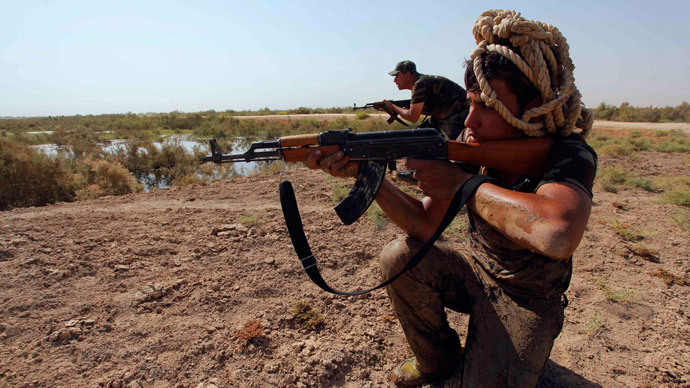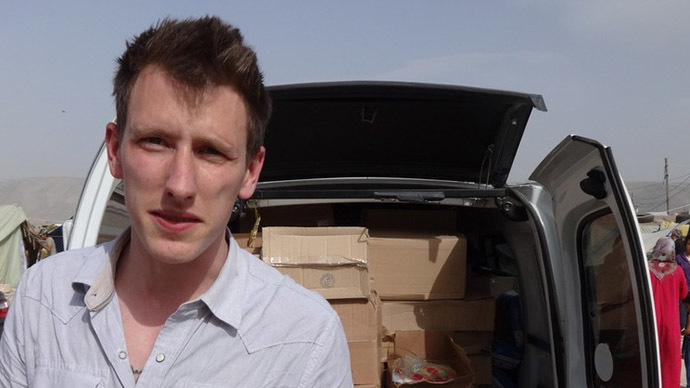‘Goal of hostage beheadings by IS – to draw the US into Mideast’

Beheadings of hostages are designed as a big provocation, aimed at pushing the US to come into the region and not at warning it to keep out of Syria and Iraq, Jeremy Salt, professor of Middle Eastern history and politics, told RT.
RT:So five foreign hostages are dead now, but so far the killings don't appear to have deterred the West in its fight against the Islamic state, so what's the group hoping to achieve with another beheading?
READ MORE:ISIS video shows beheading of US hostage Peter Kassig
Jeremy Salt: First of all, I think that we should mention that it wasn’t just the American, who was beheaded. There were at least 18 Syrian soldiers, who were lined up and murdered by these people, with 18 members of the Islamic State standing behind them with knives. This wasn’t done in a forest; this wasn’t done in a valley; this wasn’t done at night – it was done in broad daylight for the world to see. And behind the killing of an American and other foreign hostages lies the murder of very large numbers of Syrians and Iraqis, most of them – Muslims, but also Christian and members of other groups.
And when it comes to why they’re doing this, when they say that they want to warn America to keep out of Syria and Iraq, I think the reverse is true. If we look at the fundamental treaties that seem to be guiding their actions, called the ‘Management of Savagery,’ we can see that the game plan is actually to draw the US into the Middle East because the understanding is that the US is exhausted and doesn’t want any more wars in the Middle East, and therefore it would be a soft target. The template for that is what happened to the Soviet Union after it invaded Afghanistan. So, I think, actually, the opposite is true. They want the Americans to come in. And, actually, this is designed as a provocation, a very big provocation. It can’t be regarded anything other than that. Kill American citizens and then say ‘We don’t want you to come to Iraq and Syria’ – it doesn’t make any sense at all because if anything, it’s going to generate a greater American determination to do something.

RT:You mentioned the execution of a group of Syrian soldiers. The ISIS fighters also said that American servicemen will be next. Do you think it’s a real threat or more a provocation?
Political analyst Ibrahim Alloush on ISIS beheadings: “The purpose of these beheadings is to establish a reign of terror. The Islamic State is intent on spreading its rule using terror. They believe that if they abide strictly by the letter of the law as they perceive it - and they do not necessarily perceive it correctly - then God will be on their side. So for them it’s a double-message: on one hand, they seem to be taking retribution against the strikes that Western countries and NATO have been launching against the IS; on the other hand, they are just being ‘true’ to themselves, being ‘true’ to the letter of the law, being fundamentalists.”
JS: No, it’s a provocation. I mean, every time they kill an American or an Englishman or a Frenchman – whoever they can get their hands on – of course, it’s a provocation. And it’s not designed to deter the foreign governments. It’s designed to draw them in. Because I think in the Islamic State’s mindset, Syria and Iraq, the borderlands between them will be an epicenter of a kind of a great struggle against the ‘Great Satan’, which of course is the US with its allies joining in as well. And they’re confident that they can win. And if we actually look at the latest report coming out of the Independent by Patrick Cockburn, who’s a very experienced correspondent, he quotes Kurdish leaders saying that the “Islamic State doesn’t have 30,000 to 50,000 fighting men – it has something close to 200,000.” This is a huge force. So, they obviously have a good reason to feel confidence.
RT:If the CIA is underestimating the number of ISIS fighters, what will it take to defeat them?
JS: Well, this is the big problem. The air raids carried out by the US, mostly, for the last couple of months haven’t done much damage. Because one thing that has been demonstrated is that the Islamic State is extremely adaptable. They have adapted to these air raids by dispersing materials, dispersing men. When they go into fight, they go into fight in small groups, so they are much harder to target. They’ve got all kinds of methods they’ve used to kind of try to fend off the damage done by these air raids. And it’s very clear that despite the intensity of some of these raids, they haven’t been seriously damaged. I think the only conclusion from this is that the Islamic State isn’t going to give up; it’s not open to negotiations. The Americans and others don’t want to negotiate with them anyway, not even to release hostages. And so we’re driven to the only conclusion that there can be – that the only way to defeat these people is by force. That’s the only way. And that means not air raids – that means troops on the ground. And no one wants to do that. No one wants to commit troops: Americans don’t, the British don’t, the French don’t. They want to do it from the air, but they can’t from the air. And I think the military people are saying this.
The statements, views and opinions expressed in this column are solely those of the author and do not necessarily represent those of RT.
The statements, views and opinions expressed in this column are solely those of the author and do not necessarily represent those of RT.












